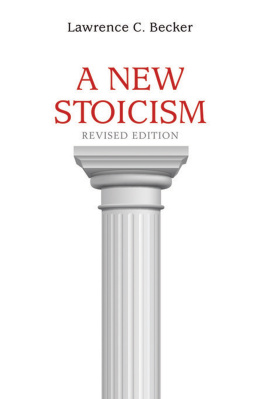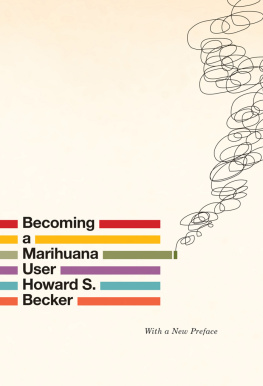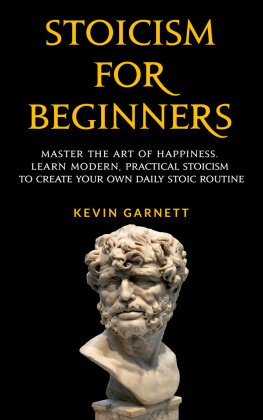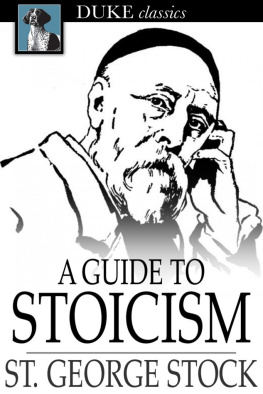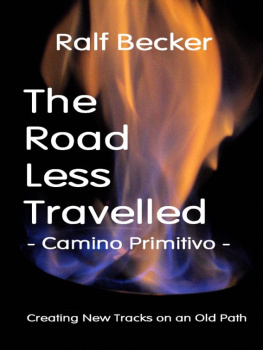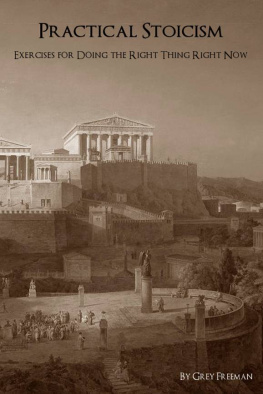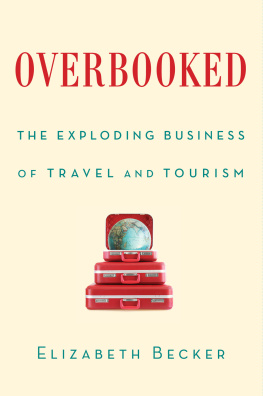Becker - A New Stoicism
Here you can read online Becker - A New Stoicism full text of the book (entire story) in english for free. Download pdf and epub, get meaning, cover and reviews about this ebook. City: Princeton;NJ, year: 2017, publisher: Princeton University Press, genre: Romance novel. Description of the work, (preface) as well as reviews are available. Best literature library LitArk.com created for fans of good reading and offers a wide selection of genres:
Romance novel
Science fiction
Adventure
Detective
Science
History
Home and family
Prose
Art
Politics
Computer
Non-fiction
Religion
Business
Children
Humor
Choose a favorite category and find really read worthwhile books. Enjoy immersion in the world of imagination, feel the emotions of the characters or learn something new for yourself, make an fascinating discovery.
- Book:A New Stoicism
- Author:
- Publisher:Princeton University Press
- Genre:
- Year:2017
- City:Princeton;NJ
- Rating:5 / 5
- Favourites:Add to favourites
- Your mark:
- 100
- 1
- 2
- 3
- 4
- 5
A New Stoicism: summary, description and annotation
We offer to read an annotation, description, summary or preface (depends on what the author of the book "A New Stoicism" wrote himself). If you haven't found the necessary information about the book — write in the comments, we will try to find it.
A New Stoicism — read online for free the complete book (whole text) full work
Below is the text of the book, divided by pages. System saving the place of the last page read, allows you to conveniently read the book "A New Stoicism" online for free, without having to search again every time where you left off. Put a bookmark, and you can go to the page where you finished reading at any time.
Font size:
Interval:
Bookmark:

A NEW STOICISM
A NEW STOICISM
REVISED EDITION
Lawrence C. Becker
PRINCETON UNIVERSITY PRESSPRINCETON AND OXFORD
Revised edition copyright 2017 by Lawrence C. Becker
Original edition published 1998
Requests for permission to reproduce material from this work should be sent to Permissions, Princeton University Press
Published by Princeton University Press, 41 William Street,
Princeton, New Jersey 08540
In the United Kingdom: Princeton University Press,
6 Oxford Street, Woodstock, Oxfordshire OX20 1TR
press.princeton.edu
Cover image courtesy of Shutterstock
All Rights Reserved
Paperback ISBN 978-0-691-17721-2
Library of Congress Control Number 2017945179
British Library Cataloging-in-Publication Data is available
This book has been composed in Sabon
Printed on acid-free paper.
Printed in the United States of America
10 9 8 7 6 5 4 3 2 1
For Charlotte
AGAIN AND ALWAYS
THESE FIFTY YEARS
Contents
Preface to the Revised Edition
Comparisons
Readers of the first edition (1998) will find that the overall project of the book remains the same, as do all its central philosophical claims, as well as the structure of the arguments for those claims. But there are five substantial changes.
THE FIRST is the reformulation of the relationships among stoic agency, virtue, and eudaimonia (happiness in the sense of a good life, a flourishing life). That change is stated in the new first section of and further explained in the new opening section of the commentary to that chapter. This has forced subtle and not so subtle changes throughout the book concerning the final end or ultimate goal in stoicism. It may be worthwhile to preview them here.
The reason for the change. The ancient Stoics claimed to be working in the eudaimonistic tradition but also claimed that virtue was the only good. Critics have persistently argued that these two claims are inconsistent. The critics point out that happiness is the final end, or ultimate goal, in the eudaimonistic tradition. How can the final end not itself be a good? And if it is a good, it is inconsistent for Stoics to say that virtue is the only good and at the same time claim to be eudaimonists.
In reply, the ancient Stoics never wavered in their claim that virtue was the only good but went on to emphasize that it was sufficient for happiness and, when pressed, would sometimes say that the two were identical, or perhaps inseparable in some sense. Even critics sympathetic to Stoicism in other respects refused to accept this response. Cicero is an example.
The first edition took the ancient Stoics at their word about virtue being the only good and tried to make the best of it by identifying virtue not with happiness but with ideal agency, which can plausibly be understood as something that is sufficient by itself to generate something resembling happiness. Thus, as the text of the first edition put it, in stoicism the final end or ultimate good is virtue and not happinessalthough virtuous agentic activity yields happiness. But this just resurrects, rather than resolves, the two goods problem and is unsatisfactory for other reasons as well.
The change itself. The account of the matter in this edition is a decided improvement in the sense that it leaves no doubt that stoicism is firmly within the eudaimonistic tradition. The revised account begins by pointing out that the same developmental process simultaneously yields three distinct things: ideal stoic agency, stoic virtue, and happiness in the sense of the stoic form of eudaimonia. Ideal stoic agency is necessary and sufficient for achieving and sustaining stoic virtue (the only good), which is in turn necessary and sufficient for producing stoic happinessthe terminus of questions about what we expect to get from stoic virtue, beyond being and acting virtuously for its own sake, and for the sake of others. Those three things are inseparable because, given their common developmental source, it is not possible to have one of the three things without also having the other two. If you have ideal stoic agency, you are going to get stoic virtue and stoic happiness as well. Stoic happiness, however, like happiness in other forms of eudaimonism, puts an end to questions about why we should develop agency and virtue. In that sense, though virtue remains the only good for Stoics, happiness is the final end.
A bonus from the change. If agency, virtue, and happiness are inseparable, a person who is making progress toward ideal stoic agency is clearly making progress toward virtue and happiness as well. This helps to understand another controversial doctrine in ancient Stoicismnamely, the claim that virtue is an all or nothing thing. The ancient Stoics claimed that virtue itself could not be a matter of degree. Progress toward virtue is a different matter, however, and that is why they presumably emphasized it so much, even coining a technical term for a person making such progress (prokoptn). Such progress can be assessed in terms of degrees of nearness to virtue itself. (An obvious analogy is uniqueness, which is also an all or nothing thing. Things that are not unique can nonetheless be far from it, close to it, or very close to it.) The first edition appreciated this point fully with respect to happiness. The assumption throughout was, and remains, that imperfect stoic moral agents will have more or less unstable forms of stoic virtue and happiness. There is now a more explicit discussion of progress toward virtue, however, to make the point clearer.
THE SECOND substantial change is the acknowledgment that specifically stoic moral training and education must figure prominently, at some stage, in the developmental story told in . Since the book itself is on stoic ethical theory, this change does not have very wide reverberations throughout the text or commentaries, but it is important nonetheless. There is no attempt to give a detailed account of stoic moral education, but there are remarks in the postscript about some possibilities for stoic teaching, training, and therapy.
.
THE FOURTH substantial change is the fact that this revised edition has updated the book in response to the remarkable growth of scholarly publication and general intellectual interest in Stoic ethics since 1998. Substantive additions can be found at the following places.
Updated bibliography and commentary. Readers will find mentionsand in some places discussionsof some important new translations of classic texts, new scholarly discussions of Hellenistic and Roman Stoicism, and stoic themes throughout the subsequent history of Western philosophy. Specifically, there are such changes in the commentary to , under the headings Reconstructed texts, Initial influences, The reception of Stoicism, Debates within the Stoic school, Contemporary sources, and Stoic holism and the autonomy of ethics. The current revival of interest in stoic accounts of living well and engagement in stoic practices is treated in the postscript. The works mentioned have complete citations in the new bibliography.
Improved arguments. There are some other changes of note. Not the least of these is the attempt to make more reader friendly by breaking up some extraordinarily long paragraphs, adding new subsection headings, and generally making the text less like something from the age before writers used punctuation.
There are also some restatements of elements in the books arguments themselves. In some cases these are quite brief; in others, not brief at all. They are flagged here for the benefit of readers who want to identify them easily:
Next pageFont size:
Interval:
Bookmark:
Similar books «A New Stoicism»
Look at similar books to A New Stoicism. We have selected literature similar in name and meaning in the hope of providing readers with more options to find new, interesting, not yet read works.
Discussion, reviews of the book A New Stoicism and just readers' own opinions. Leave your comments, write what you think about the work, its meaning or the main characters. Specify what exactly you liked and what you didn't like, and why you think so.

